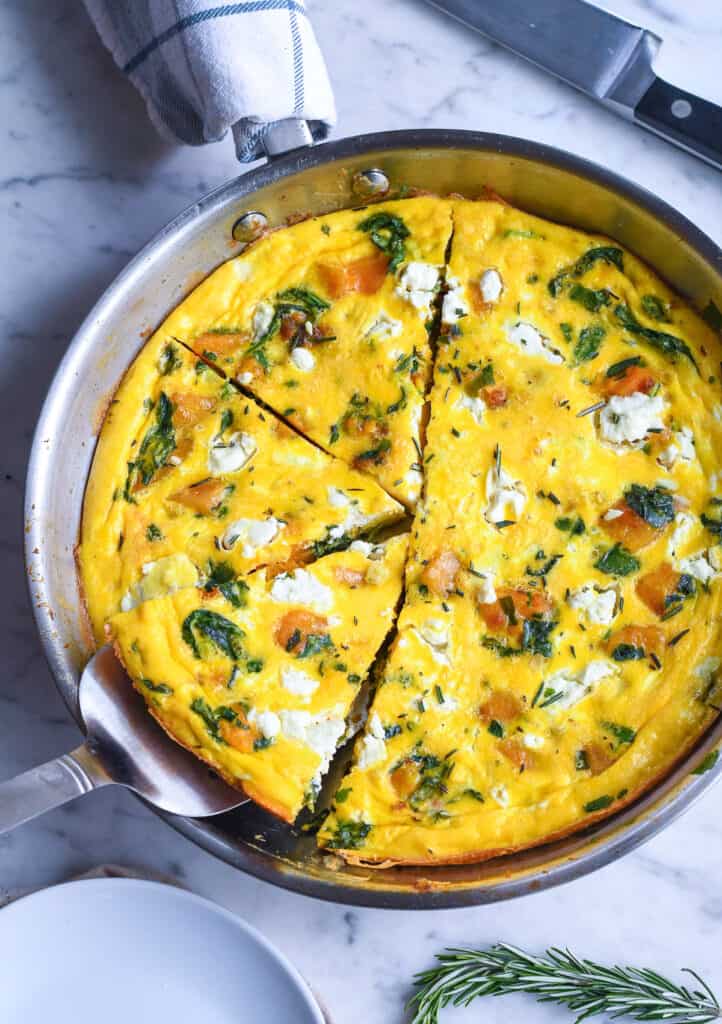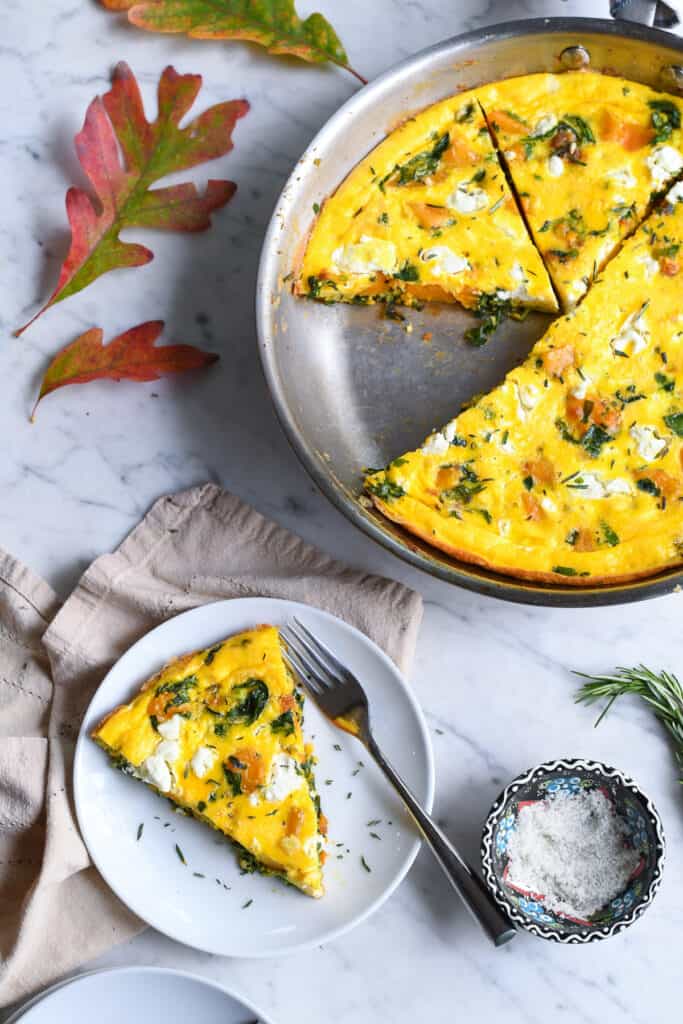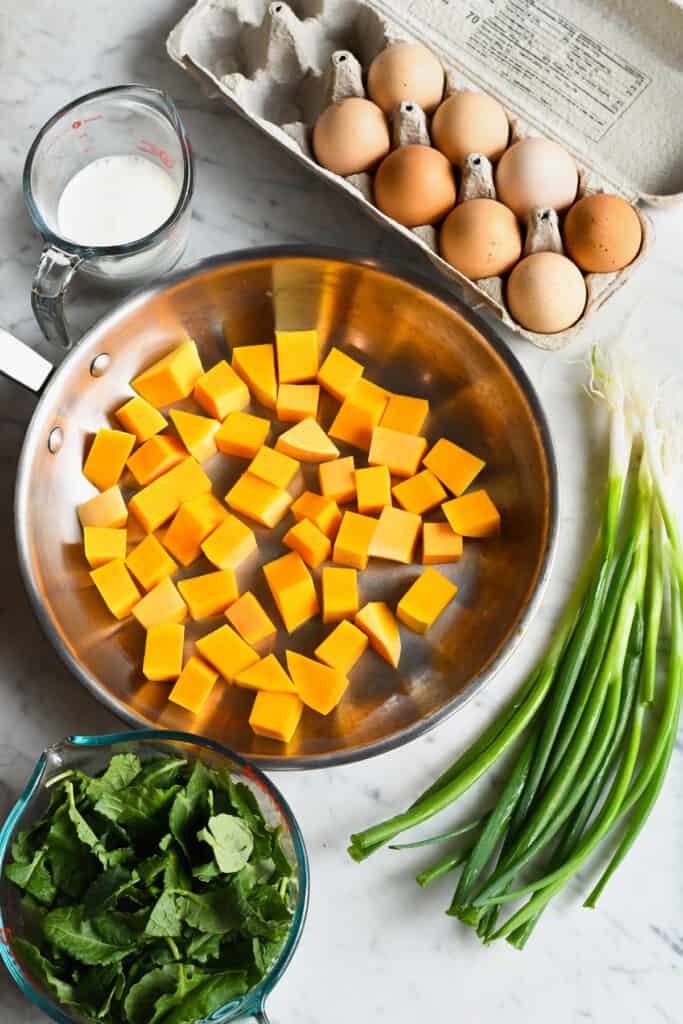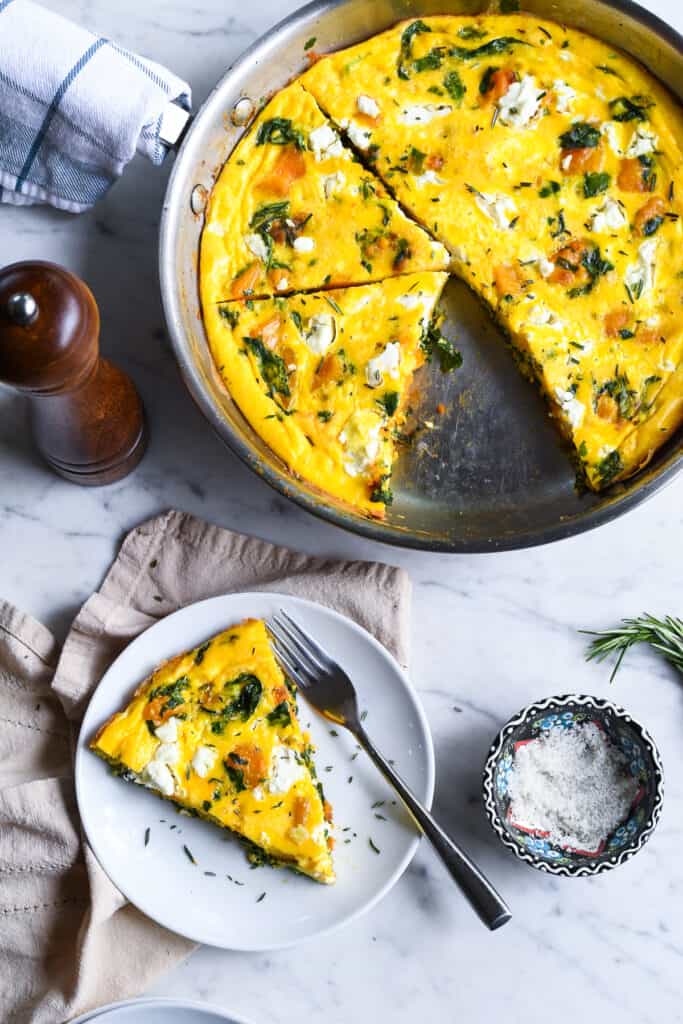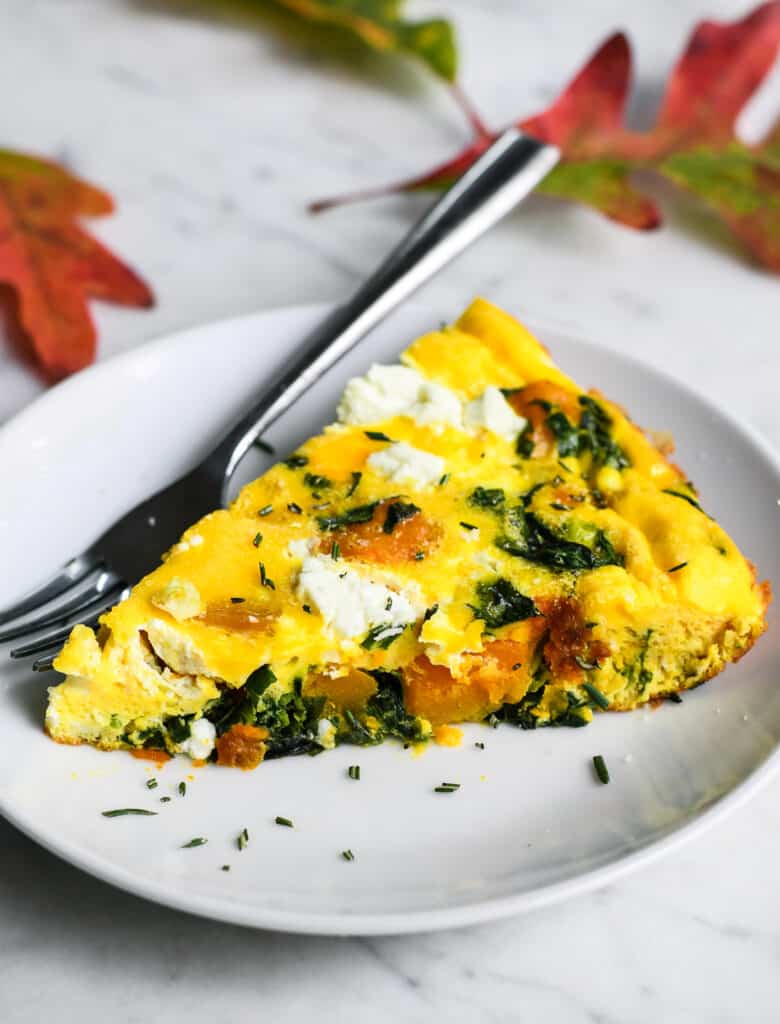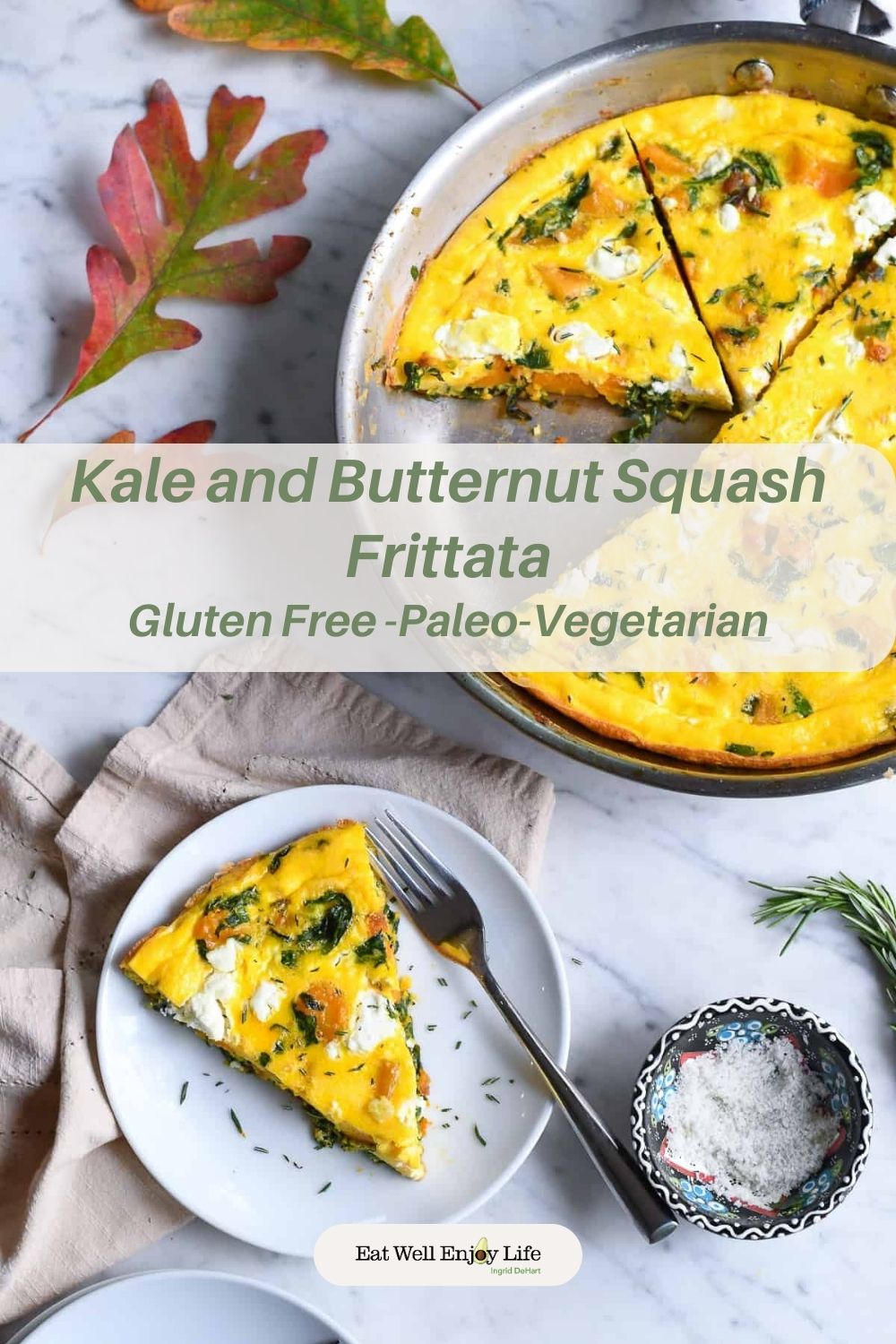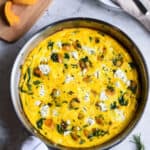Kale and Butternut Squash Frittata
Recipe Key
This Kale and Butternut Squash Frittata is a nutritious, satisfying fall recipe you can serve for breakfast, lunch or light supper. It’s has a fluffy texture and rich creamy taste. This paleo frittata recipe is also gluten free, grain free and full of flavor!
This is an easy and flavorful frittata recipe made with vibrant fall vegetables!
A frittata is an egg-based dish similar to a quiche, but without the crust. It’s usually filled with vegetables and fresh herbs, often cheese and sometimes meat. Unlike scrambled eggs or an omelet, frittatas are usually started on the stove top and finished in the oven.
It’s a really simple one pan dish that comes together in just 25 minutes. Just cook together the eggs and vegetables for a nutritious, satisfying dish that looks good enough to serve straight out of the oven.
Pasture Raised Eggs Are Super Nutritious
Do you know pasture raised eggs are one of the most nutritious foods on the planet.? Yes really!
Pasture raised eggs have more than double the total amount of omega-3 fatty acids and less than half the ratio of omega-6 to omega-3 fatty acids! This makes them an amazing source of healthy fats.
Pasture-raised eggs are a high quality protein source. Amazingly, one egg has about 6.3g of bioavailable protein! Pasture-raised eggs also contain all 9 essential amino acids.
They are a food source multivitamin, full of selenium, phosphorus, Vitamin B12, Cobalamin, Vitamin A, Vitamin D, Vitamin E, and more!
Pasture eggs are lower in cholesterol. Cholesterol is not bad for you. You need some cholesterol for optimal health! Every single cell in your body is made of cholesterol and your brain is 20-30% cholesterol.
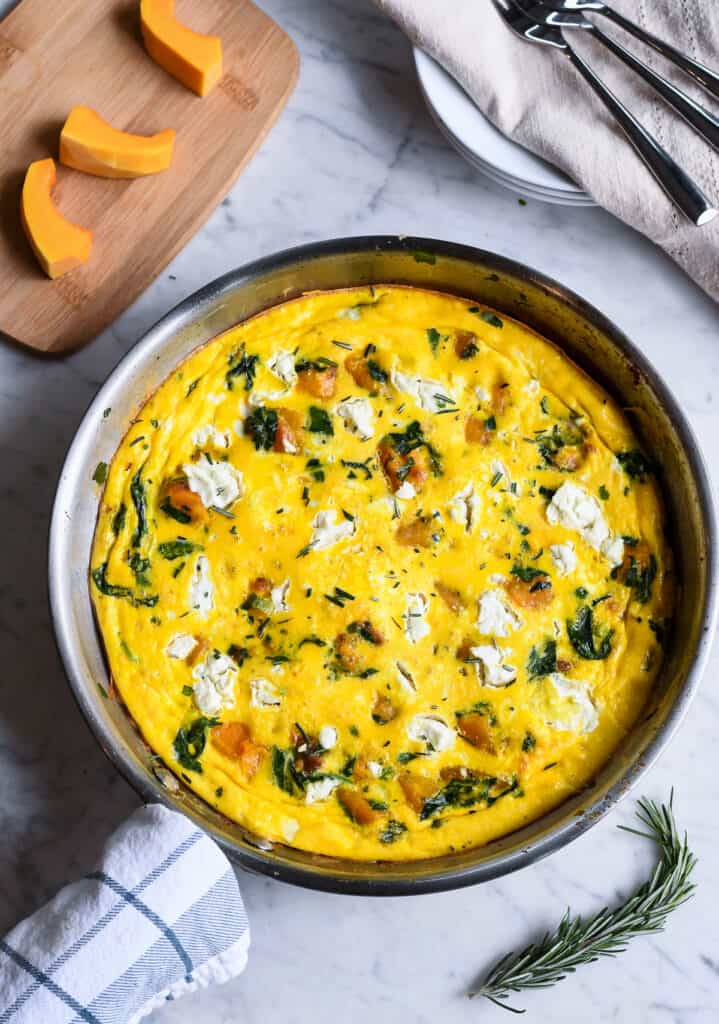
Ingredients and Substitutions for Kale and Butternut Squash Frittata
For the produce I chose butternut squash, baby kale, scallions and rosemary but the recipe is versatile and can be made easily with other fall vegetables. This is what you need and a few substitutions.
- Pastured eggs make the best frittatas. They taste richer and have an “eggier” flavor and a creamier texture than commercial eggs. Their golden to deep-orange-colored yolks indicate more nutrients.
- Butternut squash, peeled and cubed. Delicata squash can be used and the best part is you don’t have to peel it.
- Baby kale is so easy use right out of the package. If using mature kale leaves, remove the stems, use only the leaves. Spinach is good but a little less hearty.
- Milk – choose a full fat dairy milk or if you’re dairy free, almond or cashew milk. Full fat coconut milk gives the frittata a good texture but will have a slight coconut taste. Yogurt is also good. The milk provides creaminess to the egg mixture, giving it a nice custardy frittata texture.
- Rosemary is a delicious aromatic woodsy herb, perfect for fall. Thyme is nice too. Fresh is best but dried is good too. If you don’t use any herbs the frittata will still be good.
- Scallions have a fresh, somewhat-spicy, peppery flavor but are sweeter and milder than onions. Onions can be substituted.
- Olive oil
- Sea salt and fresh black pepper
- Goat cheese is a nice mild creamy cheese. Any mild cheese works. It is optional
Tips For Making the Perfect Frittata
- Spread your veggies evenly throughout the pan before pouring in the eggs. Once you pour the egg mixture in, don’t want to move the the vegetables around much. Make sure the veggies are spaced evenly in the pan to get a final frittata with veggies in every bite. (photo above)
- Use a cast-iron skillet or heavy bottomed ovenproof saute pan. You want a pan that can safely go from stovetop to oven, and conduct heat well and evenly.
- Don’t over bake. After about 8 minutes check on your frittata. It’s ready when it has a puffy body, slightly crisp on the edges, and the center jiggles ever so slightly when you give it a little shake. It will continue to cook after you remove it from the oven. Overcooking will cause the frittata to be tough.
- Be careful with the handle. Since you’re serving it right from the pan remember the handle will remain hot for a while. Place a kitchen towel on it to remind yourself not to grab it while it’s hot.
Frittata Serving Suggestions
If you’re serving your Butternut Squash frittata as part of a bigger brunch this fall, Morning Glory Bread, Moist Paleo Pumpkin Bread, Pumpkin Scones with Maple Icing or Paleo Pumpkin Muffins would be fabulous choices to go with it. Cacao Maca Latte is a warm comforting fall beverage to enjoy also.
If you want a sauce for your frittata, Vegan Pesto or Herb Avocado Sauce would be nice. I love sauces.
For lunch or a high protein, light weeknight dinner, I like to top my frittata with slices of avocado and serve it with Roasted Broccoli Salad, Roasted Sweet Potato Fries, 5 Minute Green Beans or Quinoa Tabouli Salad.
Enjoy this simple, easy, nutritious, and delicious frittata this fall. You’ll love how satisfying it is!
If you give this recipe a try, please let us know what you think! Give it some stars or leave a comment. ♥
If you like this recipe, try these other egg dishes:
Would you like to have more of these delicious healthy recipes sent to you each week? CLICK TO SIGN UP for my weekly email newsletter of recipes and tips for you to eat well and enjoy your wonderful life.
PrintKale and Butternut Squash Frittata
This Kale & Butternut Squash Frittata is a simple nutritious, satisfying fall recipe you can serve for breakfast, lunch or light supper.
- Prep Time: 15 minutes
- Cook Time: 10 minutes
- Total Time: 25 minutes
- Yield: 4 servings 1x
- Category: Breakfast, Brunch, Lunch, Dinner
- Method: Saute, Bake
- Cuisine: Paleo, Gluten Free, Dairy Free
Ingredients
- 8 eggs
- 1/3 cup milk, nut milk, (cashew milk or almond) or coconut milk
- 1 Tablespoon fresh rosemary or thyme leaves, or 1 teaspoon dried
- 1 Tablespoon extra-virgin olive oil
- ¾ pound butternut squash (1 small), peeled and chopped into 1/2” cubes
- 5 scallions, thinly sliced
- 4 cups baby kale, coarsely chopped
- ¾ teaspoon sea salt, divided
- Freshly ground black pepper
- 2 ounces goat cheese (optional)
Instructions
- Preheat the oven to 400 degrees Fahrenheit. In a large bowl, whisk together the eggs, milk, ¼ teaspoon salt and a little freshly ground black pepper.
- In a 10-inch, oven-safe heavy bottom sauté pan or cast-iron pan, heat 1 tablespoon olive oil over medium heat. Add the squash and ½ teaspoon salt and stir. Cover the pan and reduce heat to medium-low.
- Cook until the butternut is beginning to get tender, stirring occasionally, to prevent burning, about 10 minutes.
- If there is any excess moisture from the squash uncover the pan, raise the heat back to medium, and cook until the excess moisture has evaporated. If it’s dry keep the cover on and cook until the butternut squash is tender and cooked through, another 5 to 10 minutes (add a little more olive oil if the squash starts sticking to the pan).
- Add the scallions and stir. Sauté 1 minute until fragrant.
- Add the kale. Saute 2-3 minutes until tender*
- Turn the heat down to medium-low. Arrange the vegetables in an even layer in the bottom of the skillet.
- Whisk the egg mixture again and pour it into the pan. Tilt the pan to make sure the eggs are evenly distributed. Allow the eggs to settle and cook for 2 minutes. You will see the eggs at the edges of the pan begin to set.
- Dot with goat cheese if using.
- Put the pan in the oven and bake until the middle is just barely set, about 10-12 minutes.
- Remove from the oven and serve right from the pan. make sure to wrap the handle of the pan in a thick kitchen towel to prevent burns.
- Top with additional fresh herbs if desired.
Notes
If using whole kale leaves you may have to cook them longer.

